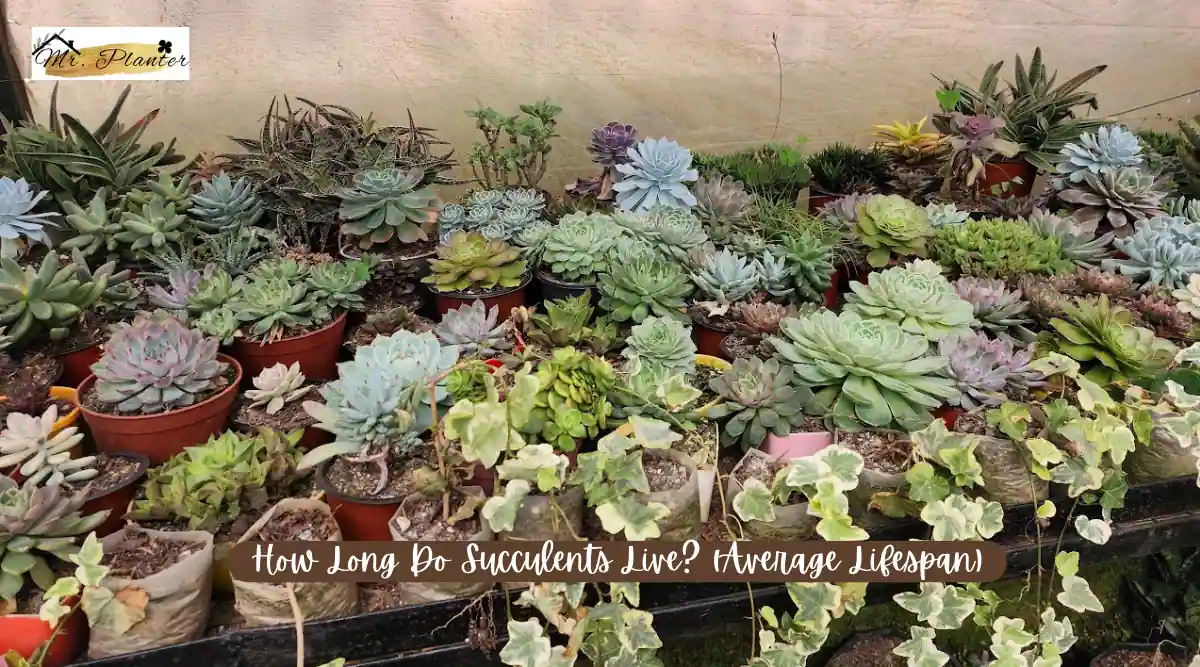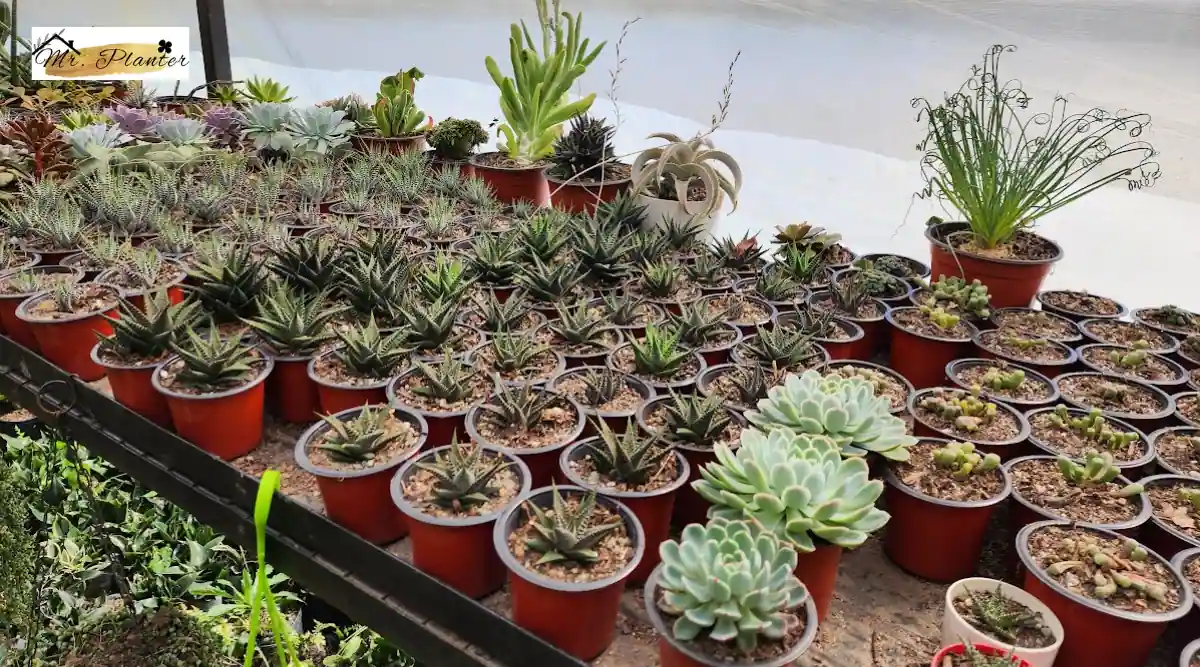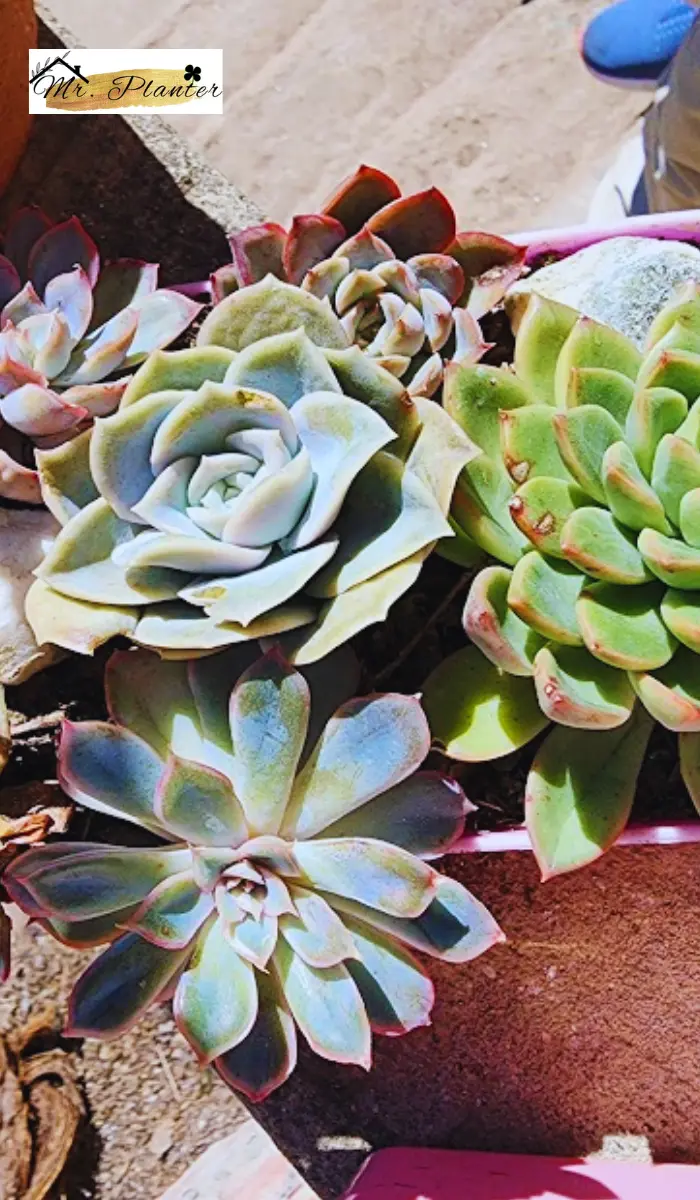If you’re a plant enthusiast, you’ve probably heard about succulents. These plants are popular for their unique appearance and low maintenance requirements. One of the most common questions people have about succulents is how long they live.
In this article, we’ll explore the lifespan of succulents and provide you with some tips on how to keep them alive for as long as possible.
The average lifespan of succulents ranges from 5 to 10 years, but some species can live for much longer. Keep in mind that the lifespan of your succulent will depend on several factors, including the species, growing conditions, and care and maintenance.
While some succulents can live for decades, others may only survive for a few years. Understanding the lifespan of your succulent is crucial if you want to ensure its longevity.

Key Takeaways
- Succulents have an average lifespan of 5 to 10 years, but some species can live for much longer.
- The lifespan of your succulent depends on several factors, including the species, growing conditions, and care and maintenance.
- Understanding the lifespan of your succulent is crucial if you want to ensure its longevity.
How Long Do Succulents Live? (Average Lifespan)
Succulents are known for their hardiness and resilience, but like all living things, they have a lifespan. The average lifespan of most succulents is between 5 and 10 years, but some can live for much longer. The lifespan of a succulent varies depending on the species, but it also depends on the growing conditions.
Succulents grown in optimal conditions will typically have a longer lifespan than those that are not. It’s important to note that not all succulents have the same lifespan.
Some succulents are monocarpic, which means they die after flowering. Others will continue to grow and produce offsets, which can extend the life of the plant.

It’s important to note that these are just averages, and the lifespan of a succulent can vary widely depending on the growing conditions. Succulents that are grown in the right soil, given the right amount of light and water, and protected from extreme temperatures can live for many years.
In addition to growing conditions, the lifespan of a succulent can also be affected by pests and diseases. Regularly inspecting your succulents for signs of pests or disease and taking action promptly can help extend the plant’s lifespan.
Lifespan of Succulents
Succulents are known for their hardiness and ability to survive in tough conditions. However, like any other living organism, succulents have a lifespan.
Understanding the factors that affect the lifespan of succulents and the longevity of different species can help you keep your succulents alive for longer.
Factors Affecting Lifespan
Several factors can affect the lifespan of succulents. These include:
- Growing Conditions: Succulents require the right growing conditions to thrive. Factors such as sunlight, temperature, soil, and water can all affect the lifespan of succulents. For example, overwatering can lead to root rot, which can shorten the lifespan of your succulent.
- Pests and Diseases: Pests and diseases can also affect the lifespan of succulents. Common pests that can attack succulents include mealybugs, spider mites, and scale insects. Diseases such as fungal infections can also affect the lifespan of your succulent.
- Genetics: The genetics of your succulent can also play a role in its lifespan. Some species of succulents are naturally long-lived, while others have a shorter lifespan.
Longevity of Different Species
The lifespan of succulents can vary widely, depending on the species.

Here are some examples:
- Aloe Vera: Aloe vera is a popular succulent that is known for its medicinal properties. Aloe vera plants can live for up to 10 years.
- Jade Plant: Jade plants are another popular succulent that is known for its longevity. Jade plants can live for up to 70-100 years.
- Haworthia: Haworthia is a small succulent that is native to South Africa. Haworthia plants can live for up to 7-10 years.
- Sempervivum: Sempervivum, also known as “hen and chicks,” is a hardy succulent that can live for up to 3-5 years.
- Echeveria: Echeveria is a beautiful succulent that is native to Mexico. Echeveria plants can live for up to 5-10 years.
It’s important to note that the lifespan of succulents can vary depending on the growing conditions and care they receive. With proper care, you can help your succulents live a long and healthy life.
Understanding Succulents
Succulents are a diverse group of plants that have adapted to survive in arid environments. They are known for their fleshy leaves, stems, and roots that store water, which allows them to survive long periods without rainfall.
In this section, we will discuss the diversity of species, monocarpic and polycarpic succulents, and indoor vs outdoor succulents.
Diversity of Species
Succulents come in a wide variety of shapes, sizes, and colors. There are over 60 plant families that contain succulent species, with the most common succulent plant families being Cactaceae, Crassulaceae, and Euphorbiaceae. Some of the most common succulent species include Aloe vera, Echeveria, and Haworthia.
Monocarpic and Polycarpic Succulents
Succulents can be classified as monocarpic or polycarpic. Monocarpic succulents, such as Aeonium kiwi, die after flowering. Polycarpic succulents, on the other hand, can continue to grow and produce new leaves and stems for many years.
The main plant of polycarpic succulents may only live for 3-4 years, but they send out lots of offsets during their life, which can take its place.
Indoor vs Outdoor Succulents
Succulents can be grown both indoors and outdoors, but it is important to note that they have different requirements for each environment.
- Indoor succulents need bright, indirect light and well-draining soil.
- Outdoor succulents, on the other hand, need direct sunlight and soil that drains well.
It is also important to note that succulents are sensitive to cold temperatures and frost, so they should be brought indoors during the winter months in colder climates.
Care and Maintenance
Taking care of succulents is relatively easy, but it does require some attention to detail. Here are some tips to help you keep your succulents healthy and thriving:
Soil and Potting
Succulents need well-draining soil to prevent root rot. A good soil mix for succulents should be a combination of sand, perlite, and peat moss. You can also buy pre-made succulent soil mixes that are specifically designed for these plants.
When you’re potting your succulent, make sure to choose a pot that has drainage holes. This will help prevent water from accumulating in the bottom of the pot and causing root rot.
Light and Sunlight
Succulents need plenty of sunlight to thrive. They should be placed in a spot that gets at least six hours of direct sunlight per day. If you’re keeping your succulents indoors, make sure to place them near a sunny window.
Watering
Succulents are adapted to survive in dry conditions, so they don’t need to be watered frequently.
In fact, overwatering is one of the most common causes of succulent death. Water your succulents only when the soil is completely dry.
When you do water them, make sure to water them deeply so that the water reaches the roots.
Fertilizer
Succulents don’t need a lot of fertilizer, but they do need some. You should fertilize your succulents once or twice a month during the growing season (spring and summer). Use a fertilizer that is specifically designed for succulents, and follow the instructions on the package.
Temperature and Humidity
Succulents prefer warm, dry conditions. They can tolerate a wide range of temperatures, but they don’t like extreme heat or cold. Keep your succulents away from drafty windows and doors, and make sure to protect them from frost in the winter.
Repotting
Succulents don’t need to be repotted very often, but they do need fresh soil every once in a while. You should repot your succulents every two to three years, or when they outgrow their current pot. When you repot them, make sure to use fresh soil and a pot that is slightly larger than their current one.
By following these tips, you can help ensure that your succulents live long and healthy lives.
Remember, succulents are adapted to survive in dry conditions, so it’s better to underwater them than to overwater them. With a little bit of care and attention, your succulents will thrive and bring beauty to your home or garden.
Growth and Propagation
Succulents are known for their easy-care nature and ability to thrive in a variety of environments. While each species has its own unique growth patterns, most succulents grow slowly and can live for many years with proper care.
Propagation is a popular way to expand your succulent collection, and there are several methods to choose from depending on the type of succulent. Some popular succulent types for propagation include jade plants, sempervivum, aloe vera, echeveria, crassula, barrel cactus, Christmas cactus, living stones, agave, and hens and chicks.
One common method for propagation is through offsets, which are small plants that grow from the base of the mother plant. These offsets can be removed and planted in their own container, where they will eventually grow into a full-sized plant.
Some succulents, like monocarpic succulents, die after flowering, so propagating through offsets is a great way to ensure the survival of the species.
Another popular method for propagation is through leaf or stem cuttings. This involves removing a leaf or stem from the mother plant and allowing it to dry out for a few days before planting it in soil or water. With proper care, the cutting will eventually grow roots and develop into a full-sized plant.
When it comes to succulent care, it’s important to consider the type of succulent you have and its specific needs. Some succulent types, like aloe vera, prefer bright, indirect light, while others, like schlumbergera, prefer low-light conditions. Succulent growth can also be affected by factors like soil type, watering frequency, and temperature.
In general, succulents prefer well-draining soil and should be watered sparingly, allowing the soil to dry out completely between waterings. Overwatering can lead to root rot and other issues, so it’s important to find the right balance for your specific succulent type.
Propagation is a great way to expand your succulent collection and can be a fun and rewarding hobby. Whether you choose to propagate through offsets or cuttings, taking the time to learn about your specific succulent type and its needs will help ensure its long-term health and survival.
Challenges in Growing Succulents
Growing succulents can be a rewarding experience, but it’s not without its challenges. Here are some common challenges you may face when growing succulents:
Pests and Diseases
Succulents are generally hardy plants, but they are not immune to pests and diseases. Some common pests that may attack succulents include mealybugs, spider mites, and scale insects.
To prevent these pests from infesting your plants, make sure to keep your succulents clean and free from debris. You can also use insecticidal soap or neem oil to control pests.
Growing Conditions
Succulents are adapted to growing in arid environments, so they require well-draining soil mix and infrequent watering. Overwatering can cause root rot, which can be fatal to your succulent.
Make sure to plant your succulent in a container with drainage holes and use a soil mix that is specifically designed for succulents.
Extreme Temperatures
Succulents can tolerate a wide range of temperatures, but they may struggle in extreme heat or cold. If you live in an area with extreme temperatures, make sure to provide your succulent with some protection. You can use shade cloth to protect your plant from the sun or bring it indoors during cold weather.
Height
Some succulents, such as the Saguaro cactus, can grow quite tall. If you’re growing a tall succulent, make sure to provide it with adequate support. You can use a stake or trellis to keep your plant upright.
Dormant Succulents
Some succulents, such as Lithops, go dormant during certain times of the year. During this time, they may appear to be dead or dying.
However, this is a natural process and your plant will come back to life when the growing season begins.
Growing Succulents Indoors
Growing succulents indoors can be challenging because they require a lot of light. If you don’t have access to natural light, you can use grow lights to provide your succulent with the light it needs.
You should also make sure to provide your plant with adequate ventilation to prevent mold and mildew.
Growing Succulents Outdoors
If you’re growing succulents outdoors, you’ll need to consider the weather conditions in your area.
Succulents can tolerate a wide range of temperatures, but they may struggle in areas with high humidity or tropical conditions. Make sure to provide your succulent with some protection from the elements, such as a shade cloth or umbrella.
Frequently Asked Questions
What is the lifespan of a succulent plant?
The lifespan of a succulent plant varies depending on the species, growing conditions, and care given. Some succulents can live for several decades, while others may only last a few years. On average, most succulent plants can live for 5-10 years with proper care.
What is the longest living succulent?
The Saguaro cactus is known to be one of the longest-living succulents, with a lifespan of up to 200 years. Other succulent plants, such as the Aloe vera and Jade plant, can also live for several decades with proper care.
How do you keep potted succulents alive?
To keep potted succulents alive, it is important to provide them with the right growing conditions. Succulents need well-draining soil, adequate sunlight, and infrequent watering. Overwatering can cause root rot and eventually kill the plant. It is also important to avoid overcrowding the pot and to provide enough space for the succulent to grow.
Do succulents ever stop growing?
Succulents can continue to grow throughout their lifespan, although the rate of growth may slow down as the plant matures. Some succulent plants, such as Aloe vera, can also produce offshoots or “pups” that can grow into new plants. With proper care, succulents can continue to thrive and grow for many years.

